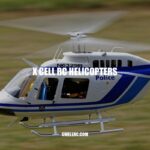Micro RC Airplanes: Your Comprehensive Guide to Miniature Flying Toys
Micro remote control airplanes, also known as mini RC planes, toy airplanes, or micro aerial vehicles, are small scale models of real aircraft that can be controlled remotely. These models are becoming increasingly popular among hobbyists, especially those who are passionate about aviation. Micro RC airplanes are designed to mimic the flight capabilities of their full-sized counterparts, allowing pilots to perform aerial acrobatics and other maneuvers on a smaller scale. These miniature aircraft are also ideal for indoor flying, as they are relatively small and lightweight, making them easy to maneuver in tight spaces. With their increasing popularity, there are now several types of micro RC airplanes available, including gliders, jets, warbirds, and helicopters. Each type of model has its own unique features and variations, making it easier for hobbyists to choose the right one for their needs and skill level. Whether you’re an aerial hobbyist or just starting to explore the world of RC aircraft, a micro remote control airplane can provide hours of entertainment and fun.
Types of Micro Remote Control Airplanes
There are several types of micro remote control airplanes that are available in the market. Each type of model has its own unique features and variations, making it easier for enthusiasts to choose the right model for their needs and skill level. Here are some of the most common types of micro remote control airplanes:
- Gliders: Micro RC gliders are designed to soar through the air without the use of a motor. These planes are ideal for beginners who want to learn how to fly RC airplanes without having to worry about engine maintenance or fuel. Gliders can also be used for aerial photography and other similar uses.
- Jets: Micro RC jets are designed to mimic real jet planes, with sleek designs and high speeds. These models are popular among more experienced pilots who want to perform aerobatic maneuvers at high speeds.
- Warbirds: Warbirds are micro RC planes that resemble planes from World War II. These models are designed to look more realistic and often have intricate details such as special paint jobs and realistic decals.
- Helicopters: Micro RC helicopters are smaller versions of real helicopters, with rotors that spin to keep the aircraft aloft. These models are popular among those who want to learn how to pilot a helicopter.
For those who are looking for more information or to purchase micro remote control airplanes, there are several websites and online stores that sell such models. One such website is Hobbyking, which offers a wide variety of micro RC airplanes and accessories. Other popular online stores include Amazon and Banggood, which also offer a range of models and accessories for sale.
How many types of RC planes are there?
RC planes are an exciting way to experience the thrill of flying without ever leaving the ground. These planes come in a variety of shapes and sizes, with each type having its own unique advantages. Let’s take a look at the different types of RC planes available for enthusiasts.
1. Trainer RC planes: These planes are perfect for beginners as they are easy to handle and are designed to be stable in flight.
2. Sport RC planes: As the name suggests, these planes are built for performance and are suitable for advanced pilots who want more speed and agility.
3. Scale RC planes: These planes are replicas of real planes and are perfect for hobbyists who enjoy the visual aspect of flying. They can be highly detailed and accurate.
4. 3D RC planes: These planes are designed for advanced pilots who want to perform aerobatic maneuvers in flight. They can hover, roll and flip effortlessly.
5. Electric RC planes: These planes are powered by electric motors and are more environmentally friendly compared to the gas and nitro-powered planes. They are also quieter and easier to maintain.
6. Gas/nitro-powered RC planes: These planes use fuel-powered engines and are typically more powerful and have longer flight times compared to electric planes. They are the preferred choice for experienced pilots who want more power and speed.
So, whether you are a beginner or an experienced pilot, there is an RC plane type that suits your needs and flying style.
How to Choose the Right Micro Remote Control Airplane
Choosing the right micro remote control airplane can be a daunting task for beginners. However, there are several factors to consider when selecting the perfect model for your needs and budget. Here are some tips to help you choose the right micro remote control airplane:
- Size: Micro RC airplanes come in various sizes, ranging from palm-sized models to larger models that are a few feet long. Consider where you will be flying your airplane and choose a size that is appropriate for that space.
- Power source: Micro RC airplanes can be powered by electric motors or fuel engines. Electric motors tend to be easier to maintain and are more environmentally friendly, but fuel engines offer longer flight times and higher speeds.
- Skill level: Consider your experience level when selecting a micro RC airplane. Beginners should choose a model that is easy to fly and maneuver, while more experienced pilots may prefer more complex models that offer a greater range of aerobatic maneuvers.
- Building vs. Ready-to-Fly: Some models require assembly before they can be flown, while others come pre-assembled and ready to fly right out of the box. Consider whether you want to build your own model airplane or purchase a pre-built one.
Interesting fact: Did you know that micro remote control airplanes were first introduced in the 1970s?
Some websites that offer information on how to choose the right micro remote control airplane for your needs include RC Groups, Model Airplane News, and Flying Giants. Additionally, some popular micro RC airplane models include the E-flite UMX Timber, the ParkZone F4F Wildcat, and the Flyzone DHC-2 Beaver. See the below table for a comparison of each model’s features:
| Model | Size | Power Source | Skill Level | Building Required? |
|---|---|---|---|---|
| E-flite UMX Timber | 26.3 in wingspan | Electric motor | Intermediate | No |
| ParkZone F4F Wildcat | 34.5 in wingspan | Electric motor | Beginner | No |
| Flyzone DHC-2 Beaver | 59.5 in wingspan | Electric motor | Advanced | Yes |
Building and Flying Micro Remote Control Airplanes
Micro remote control airplanes is a popular hobby that offers a great sense of accomplishment and entertainment. Below are some tips for building and flying your micro RC airplane:
- Building: Make sure to follow the instructions carefully when building your micro RC airplane to ensure it is assembled correctly and safely. Pay close attention to the alignment of the components and the balance of the airplane.
- Flying: Practice flying your micro RC airplane in a safe and open space, free from obstacles and people. Start with basic maneuvers and gradually move on to more complex ones as you become more comfortable with your airplane. Always make sure to keep the airplane in your line of sight.
- Safety equipment: Always wear eye protection and keep the airplane away from your face and body while it is in flight. Also, make sure to keep your hands away from the propeller.
Interesting fact: Did you know that micro remote control airplanes have been used for aerial photography and surveillance by law enforcement and military personnel?
Some websites that offer information on building and flying micro RC airplanes include RC Groups, Flite Test, and RC Universe. Additionally, some popular products for building and sustaining micro RC airplanes include electrical components, batteries, and flight controls. See the below table for a comparison of each product’s features:
| Product | Price | Power Source | Compatibility | Application |
|---|---|---|---|---|
| Brushless Motor | $20 | Electric | Fits most micro airplanes | Increases the power of the airplane |
| Lipo Battery | $25 | Electric | Fits most micro airplanes | Provides extended flight time |
| Flight Controller | $40 | Electric | Compatible with certain micro airplanes | Allows for more precise control of the airplane |
How much does it cost to build a RC plane?
Building a remote-controlled (RC) plane can be an exciting and rewarding hobby. It’s a great way to explore the world of aviation and to bond with other enthusiasts. One question that often arises when embarking on such a project is, “How much does it cost to build an RC plane?” The answer to this question can vary greatly depending on the type of plane you want to build and the materials and tools you choose to use.
If you’re just starting and want to build a simple, beginner-friendly RC plane, you can expect to spend around $150 to $200. This would cover the cost of the kit, the electronics, the radio control transmitter and receiver, the battery, and other small supplies such as glue and tape.
However, if you’re looking to build a more advanced and powerful RC plane, the costs can mount up quickly. The cost of materials, especially if you’re using high-quality materials such as carbon fiber, can range from $500 to $1000 or more. Additionally, more complex planes often require more advanced electronics and equipment, which can add another $500 to $1000 to the total cost.
It’s important to keep in mind that the cost of building an RC plane is not just limited to the initial startup costs. You’ll also need to consider the ongoing cost of maintenance and repairs, as well as the cost of upgrading your electronics and equipment as technology advances.
In conclusion, the cost of building an RC plane can vary significantly depending on the type of plane you want to build and the materials and tools you choose to use. While it can be an expensive hobby, it’s also an incredibly rewarding one that can provide hours of entertainment and the chance to learn new skills.
Maintenance and Repair of Micro Remote Control Airplanes
Proper maintenance and care are necessary to ensure the longevity of your micro remote control airplane. Below are some tips for maintaining and repairing your micro RC airplane:
- Cleaning: Clean your airplane regularly, especially after each flight. Use a soft, dry cloth to wipe down the exterior and use a dry, compressed air canister to blow out any debris that may have accumulated on the interior components.
- Battery: Always make sure to charge your battery properly and store it in a cool and dry place when not in use. Replace the battery if you notice any signs of wear and tear, such as bloating.
- Repairs: Assess the damage of your airplane and replace or repair the damaged parts accordingly. Check for any cracks or broken pieces and use glue or tape to reattach them back together. If the damage is severe, consider seeking professional repair services.
Interesting fact: Did you know that micro remote control airplanes are also used for academic research and environmental monitoring, such as for studying migratory patterns of birds or tracking pollution levels?
Some websites that offer information on maintaining and repairing micro RC airplanes include RC Groups, Flite Test, and Model Airplane News. Additionally, some popular products for maintenance and repair of micro RC airplanes include glue, tape, and replacement parts such as propellers and wings. See the below table for a comparison of each product’s features:
| Product | Price | Compatibility | Application |
|---|---|---|---|
| Cyanoacrylate (CA) Glue | $5 | Most micro airplanes | Binds broken pieces together |
| Electrical Tape | $3 | Most micro airplanes | Secures or covers damaged parts |
| Propeller Set | $10 | Compatible with certain micro airplanes | Replaces damaged or worn out propellers |
| Wing Set | $15 | Compatible with certain micro airplanes | Replaces damaged or worn out wings |
Flying micro remote control airplanes can be a fun and exciting hobby, but it is important to keep in mind the potential hazards and follow safety guidelines to ensure a safe and enjoyable experience. Below are some safety precautions to remember when flying micro RC airplanes:
- Know your surroundings: Always fly in an open area with no obstructions or people in the way. Avoid flying your airplane near airports, power lines, or other hazards.
- Check your equipment: Make sure your airplane is in good working condition before each flight. Inspect the battery, propellers, and wings for any signs of damage or wear and tear.
- Follow regulations: Familiarize yourself with local regulations and restrictions on flying RC airplanes. Abide by any height and distance limitations and always fly within your line of sight.
- Use protective gear: Wear protective gear such as safety glasses and gloves to avoid injury in case of an accident.
- Be mindful of weather conditions: Avoid flying your airplane in strong winds, rain, or other adverse weather conditions that can affect the plane’s stability.
Interesting fact: Did you know that micro remote control airplanes have been used for military applications such as surveillance and reconnaissance?
Websites such as the Academy of Model Aeronautics (AMA) offer information and resources on RC airplane safety. Additionally, some popular products for safety during RC flights include safety goggles, gloves, and warning markers. See the below table for a comparison of each product’s features:
| Product | Price | Compatibility | Application |
|---|---|---|---|
| Safety Goggles | $15 | One size fits most | Protects eyes from flying debris |
| Safety Gloves | $12 | One size fits most | Protects hands from cuts and scratches |
| Warning Markers | $8 | Can be attached to most micro airplanes | Signals to others that a RC airplane is flying nearby |
How far can a remote control plane fly?
Remote control planes are perfect for anyone interested in aviation who wants to indulge their passion without spending a lot of money. They are perfect for beginners and experts alike. However, one common question that most people ask is “How far can a remote control plane fly?”
Well, the answer to that question may vary depending on a range of factors such as the type of plane, the pilot’s skills, weather conditions, and the size of the fuel tank, among others.
For instance, most electric-powered remote control planes can stay in the air for approximately 20-30 minutes, and they can cover a distance of up to 500 meters. On the other hand, gas-powered remote control planes can fly for around 40-60 minutes and cover distances of up to 5 miles.
It is also important to note that the range of radio signals can limit the distance that the remote control plane can travel. Generally, most remote control planes have a range of up to a kilometer, but with modern technology, some can fly even further.
Overall, the range of a remote control plane’s flight depends on several factors, including the pilot’s skills, the type of plane, and fuel tank size, among others. Therefore, it is essential to consider all these factors before buying a remote control plane.
Conclusion
Flying micro remote control airplanes can be a rewarding and entertaining experience for aviation enthusiasts of all ages. Micro RC airplanes are relatively affordable, easy to operate, and come in various shapes and sizes. Whether you prefer flying gliders, warbirds, or helicopters, there is a micro RC airplane model that suits your preferences and skill level. However, it is equally essential to follow safety guidelines to avoid mishaps and ensure that you and others remain safe during the flight.
Moreover, flying micro remote control airplanes is an ideal way to learn about aerodynamics and aviation principles while providing you with a fun and intellectually stimulating hobby. So why not give it a try and experience the thrill of flying a micro RC aircraft yourself? With a little bit of practice and patience, you may soon become an expert aviator.
In conclusion, micro remote control airplanes are fascinating miniature aircraft models that provide a thrilling and educational experience for enthusiasts. Whether you build, fly, or maintain these models, there is no denying the joy and satisfaction that comes with the hobby. So why not start exploring the wonderful world of micro RC airplanes today?



